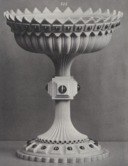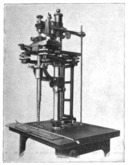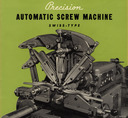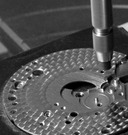Even after the ../ Preliminary Studies in Artifice, there are still more "preliminaries" - or at least topics that are going to come up often and which, if ignored, will keep one (have kept me) from doing good work.
Note also that machining is but one of several Basic Processes in artifice such as Casting, Metalsmithing, etc. For hand work as typically done in the machine shop, especially, see Fitting.
Note: Hand scraping is an intermediate case - a hand process used primarily to create machines. I'll cover it not here but in the ../ Fitting Notebooks. The finishes produced by some types of hand scraping (especially frosting and flaking) are sometimes conflated with other finishes; for a discussion of these, see the Surface Finishing Notebooks (below).

Cutting Tool Forming and Sharpening
[NOT DONE (mostly)]
Understanding Benton's insight into the importance of removable spindles for matrix engraving.

Collets
System Deckel Collets (for GK21, etc.) Gorton collet notes. Rivett New Style ("NS") collets; e.g. 4NS collets (used also on Gorton 375 Cutter Grinder).

Tapers
For now, just some analytic and historical information on the now uncommon but quite beautifully designed Jarno taper.
This subject is closely related to that of collets (see above) as every collet must incorporate a taper.

Spindle Noses and Tool Holders
For now, just some historical research on the "NMTB" spindle noses for milling machines (and their various alternative names).

Measuring, Inspecting, Testing (by machine)
Wilder Model A Micro-Projector (Literature). Hardness Testers (Bibliography Only).
These Notebooks cover only methods using machines (of greater or lesser complexity). For measuring, inspecting, and testing with hand instruments, see ../ Basic Processes -> Fitting -> Measuring, Inspecting, and Testing.)
The emphasis here is on full-size but small-shop tools and practices. For small-scale tools and workshop practice, see ../ Horology -> Literature -> Horological Workshop Methods.
The selection of topics here will seem quite odd to some. Ornamental Turning and Rose & Straight-Line Engine Work have always been unfamiliar to most machinists. The Metalworking Shaper will be unfamiliar to modern machinists; it is considered entirely obsolete. Modern tool and die makers will find the bits on Pantograph Engraving quaint and old-fashioned. In general the complete lack of computer control for any of the tools here looks back to the 19th and early 20th centuries, not forward. The Surface Grinder, however, is not as common in hobby workshops as it should be.

General Instructional Materials
These Notebooks collect books, courses, videos, etc. (both in digital reprint and as bibliographic references) which cover machine shop practices generally. Works devoted to specific types of machine tools will be found with those tools in later Notebooks, below.
Also beginner's/apprentice's projects.

Plain Turning
That is, ordinary lathe use. It's only "plain" turning when compared to the relatively esoteric field of " ornamental turning."Literature on specific lathes: Clausing-Colchester 13" / Colchester Master 2500. Hjorth.

Ornamental Turning
And Rose, Straight-Line, & Brocade Engine Work (that is, Engine Turning). Their Literature.
For a discussion of the differences between Spotting and Engine Turning, see Surface Finishing -> Engine Turning vs. Spotting.

Pantograph Engraving
(And pantographic "profile milling" and die sinking.) Links to Gorton P1-2 and New Hermes Notebooks.
For primarily non-pantographic die sinking, see Milling -> Die Sinking.
For tracer-controlled machine tools as they developed in the middle of the 20th century, see also the Notebooks on Automated Machine Tools, below.

Automated Machine Tools
Cam. Tracer. Record-Playback. NC. CNC.
This set of Notebooks will be a strange miscellany. It came about because, against my expectations and better judgment, I became interested in homebrew/D.I.Y. CNC machine tools. This led to a couple of hands-on building and programming projects, which needed someplace to be documented. Because it is always important to understand where things came from, this also led to some research into the earlier NC machine tools (and some reprints from this literature).
Finally, as I am now convinced that this field was not a post-WWII invention in computing but rather the next step in a long and economically important history of analog automated machine tools, these Notebooks will contain a scattered bit of the literature of Automatic Screw Machines and the like. But note that pantographically controlled machine tools are an important part of this history of analog control. These are considered in several Notebooks, links to which are collected above.

The Metalworking Shaper
An older and more beautiful tool than the woodworking "shaper."

Milling
Horizontal Milling. [Vertical Milling.] Die Sinking (non-pantographic).

Surface Grinding
Reid 2-C.
Note: Surface grinding is a metal shaping operation which is employed to produce parts to particular sizes and shapes (usually very accurately). While a surface-ground part has a particular finish to it, and while that finish may in many cases be sufficient for final use, the processes of "surface finishing", which are intended to give a surface a particular finish without significant removal of material or shaping of the part, are essentially different.

Presswork
Walsh No. 2 Spotting Press.
Of course, metalworking presses need dies, whether pantographically engraved or made by other methods of die sinking.

Auxiliary Tools & Appliances
General-purpose tools and appliances used with more than one different kind of machine tool.
Setup Blocks ("1-2-3 blocks").
For tools and appliances specific to one tool, see that tool. For tools used in bench work (which may often also be used on machine tools), see Fitting.

Surface Finishing
Processes intended to give a surface a particular finish without the significant removal of material. Identification of a number of horological and fine instrument finishes. A discussion of the distinction of Engine Turning vs. Spotting.

A Tour of the Machine Shop
Mostly this is so I can show the shop to friends I know only through electronic correspondence. The general reader of these pages won't be interested.
See also the Tour of the Type Foundry and Press
All portions of this document not noted otherwise are Copyright © 2007, 2011, 2018 by David M. MacMillan.
Circuitous Root is a Registered Trademark of David M. MacMillan.
This work is licensed under the Creative Commons "Attribution - ShareAlike" license, version 4.0 International. See http://creativecommons.org/licenses/by-sa/4.0/ for its terms.
Presented originally by Circuitous Root®